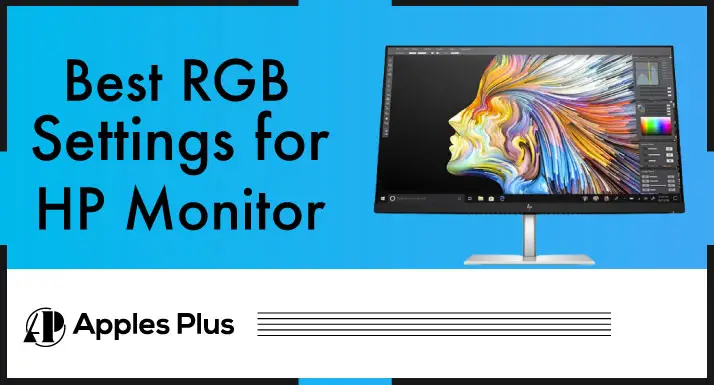Optimizing the image quality of your HP monitor is essential for a comfortable and enjoyable viewing experience, whether you’re using your monitor for work or leisure.
One important aspect of image quality is color accuracy and balance, which can be improved by adjusting the RGB settings. However, finding the best RGB settings for your HP monitor can be subjective and complex and may vary depending on your preferences and viewing conditions.
In this blog post, we will explore the different steps you can take to adjust the RGB settings of your HP monitor and provide tips for finding the optimal settings for your needs.
Best RGB Settings for HP Monitor

The “best” RGB settings for an HP monitor will depend on various factors, such as the monitor’s model, the room’s lighting conditions, and personal preferences. However, I can provide some general guidance on how to adjust the RGB settings to optimize the color and contrast of your HP monitor:
1. Start with the Default Settings:
Starting with the default settings means resetting your HP monitor to its factory settings, which will restore all settings to their original values. It is important because the default settings are typically optimized for general use and provide a good baseline for adjusting the monitor’s settings to your liking.
To reset your HP monitor to its default settings, follow these steps:
- Turn on your monitor and navigate to the monitor’s settings menu using the buttons on the front or side of the monitor.
- Look for a “Reset” or “Factory Reset” option in the settings menu. The location of this option may vary depending on your monitor model, so consult your user manual if you need clarification.
- Select the “Reset” or “Factory Reset” option and confirm that you want to reset all settings to their default values.
- Wait for the monitor to restart and apply the default settings.
Once the monitor has been reset to its default settings, evaluate the image quality and note any issues you notice. For example, the default settings may be too bright or warm for your liking, or the contrast may be too low. These issues will guide your subsequent adjustments to the monitor’s settings.
By starting with the default settings, you have a reference point from which to adjust the monitor’s settings to your liking. You can also ensure that you start with consistent and reliable image quality.
2. Adjust the Brightness and Contrast:
Adjusting the brightness and contrast of your HP monitor is an important step in optimizing image quality. These settings affect the overall luminance and contrast of the image, which can significantly impact how colors and details are perceived. Here’s how to adjust the brightness and contrast of your HP monitor:
- Start by displaying an image with shades from black to white, such as a grayscale gradient. You can find such images online or use a built-in monitor test pattern.
- Adjust the brightness setting until the blackest part of the image appears as deep black, without any visible brightness or glow. Be careful not to set the brightness too low, as this can result in an image that is too dark and difficult to see. If the image is too dark, increase the brightness until the blackest part of the image is visible but still appears deep black.
- Next, adjust the contrast setting until you can clearly distinguish between shades of gray. It means that the lightest parts of the image should appear bright white, while the darkest parts should still appear deep black. If the contrast setting is too high, the image may appear washed out or over-exposed, with details lost in bright areas. If the contrast is too low, the image may appear flat or dull, lacking contrast and detail.
- Adjust brightness and contrast settings until you achieve the optimal balance for your viewing conditions and personal preferences. Make small adjustments to each setting, and take breaks to rest your eyes if needed.
It’s important to note that the optimal brightness and contrast settings will vary depending on the ambient lighting in your environment and your personal preferences. For example, if you use your monitor in a dimly lit room, you may prefer a lower brightness setting to reduce eye strain.
Additionally, if you are working with color-critical content, such as photo or video editing, adjust the brightness and contrast settings to match the color profile of your content.
3. Adjust the Color Temperature:
Adjusting the color temperature of your HP monitor is another important step in optimizing image quality. The color temperature setting controls the overall warmth or coolness of the image and can significantly impact how colors are perceived.
Here’s how to adjust the color temperature of your HP monitor:
- Start by displaying an image with various colors, such as a photograph with skin tones and natural landscapes.
- Look for the color temperature setting in your monitor’s menu, typically labeled “Color Temperature” or “White Balance.” The available options may vary depending on your monitor model but typically include presets such as “Cool,” “Normal,” and “Warm.”
- Select a preset that looks natural and comfortable to your eyes. A higher color temperature (above 6500K) will produce a cooler, bluer image, while a lower color temperature (below 6500K) will produce a warmer, redder image. Most people find a color temperature between 5500K and 6500K comfortable and natural.
- If your monitor offers more advanced color temperature settings, you can further fine-tune the color temperature by separately adjusting the red, green, and blue levels. It can help correct color casts or adjust for specific lighting conditions.
- Adjust the color temperature until you achieve the optimal balance for your viewing conditions and personal preferences. Make small adjustments to each setting, and take breaks to rest your eyes if needed.
It’s important to note that the optimal color temperature settings will vary depending on the ambient lighting in your environment and your personal preferences. For example, if you are working in a dimly lit room, you may prefer a warmer color temperature to reduce eye strain.
Additionally, suppose you are working with color-critical content, such as photo or video editing. In that case, you should adjust the color temperature to match the color profile of your content.
4. Fine-tune the RGB settings:
Fine-tuning your HP monitor’s RGB settings is another step to optimize image quality. The RGB settings control the balance of red, green, and blue colors in the image and can significantly impact how colors are perceived. Here’s how to fine-tune the RGB settings of your HP monitor:
- Start by displaying an image with a range of colors, such as a photograph with a wide range of hues.
- Look for the RGB settings in your monitor’s menu, which may be labeled as “Color,” “Color Adjust,” or “Picture.” The available options may vary depending on your monitor model but typically include sliders or numerical values for each RGB color.
- Start by adjusting the red (R) slider or value. Increase the red value to make the image appear warmer or more red-toned, and decrease the red value to make the image appear cooler or more blue-toned.
- Next, adjust the green (G) slider or value. Increase the green value to make the image appear more green-toned, and decrease the green value to make the image appear more magenta-toned.
- Finally, adjust the blue (B) slider or value. Increase the blue value to make the image appear cooler or more blue-toned, and decrease the blue value to make the image appear warmer or more yellow-toned.
- Adjust the RGB settings until you achieve the optimal balance for your viewing conditions and personal preferences. Make small adjustments to each setting, and take breaks to rest your eyes if needed.
It’s important to note that fine-tuning the RGB settings can be more advanced and subjective and may require some trial and error to find the optimal settings.
Additionally, suppose you are working with color-critical content, such as photo or video editing. In that case, you should use a color calibration tool or consult a professional to ensure accurate color representation.
5. Save Your Settings:
After you have adjusted the various settings on your HP monitor, it’s essential to save your settings to ensure they are applied consistently each time you use them.
Here’s how to save your settings:
- Once you have adjusted the settings to your liking, navigate to the “Save” or “Apply” option in your monitor’s menu.
- Select the option to save your settings. It may involve pressing a button on the monitor or selecting a “Save” or “Apply” option in the menu.
- Some monitors may also offer the option to save different settings profiles, which can be helpful if you have different settings for different viewing conditions or tasks. For example, you may want a brighter and cooler setting for daytime use and a dimmer and warmer setting for nighttime use.
- If your monitor does not have a dedicated “Save” or “Apply” option, you may need to exit the menu, and your settings will be automatically saved.
- It’s a good idea to periodically check your settings to ensure they are optimal and adjust as needed.
It’s important to note that some monitors may reset to their default settings if they are unplugged or lose power. In these cases, you may need to readjust or reapply your saved settings manually.
Additionally, if you use your monitor with multiple devices, such as a desktop computer and a laptop, you may need to adjust your settings separately for each device.
It’s important to note that the “best” RGB settings will vary depending on the content you view and your preferences. Additionally, if you use your HP monitor for professional color work, such as a photo or video editing, consider using calibration tools to ensure accurate and consistent color representation.
Conclusion
In conclusion, adjusting your HP monitor’s RGB settings can significantly improve your display’s color accuracy and balance, leading to a more comfortable and enjoyable viewing experience.
By starting with the default settings, adjusting the brightness and contrast, fine-tuning the color temperature, and tweaking the RGB settings, you can find the optimal settings for your preferences and viewing conditions.
Remember to save your settings to ensure consistency, and periodically check your settings to make adjustments as needed. These tips allow you to optimize your HP monitor for optimal image quality and enjoy your content thoroughly.

Meet Harry, the author of Apples Plus! Harry is a highly skilled electronic engineer passionate about testing and reviewing tech products like monitors and soundbars. With years of experience in the industry, Harry has developed a keen eye for detail and an in-depth understanding of the latest tech trends and developments.


